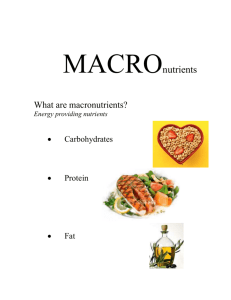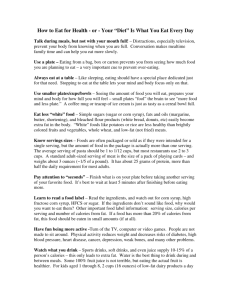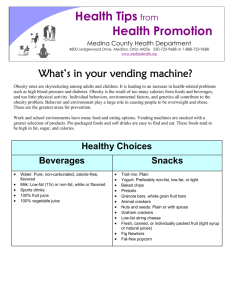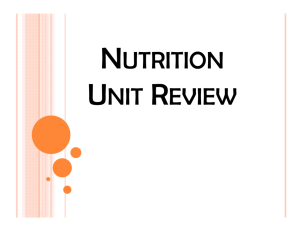Food Labels & Nutrition Facts Guided Notes
advertisement
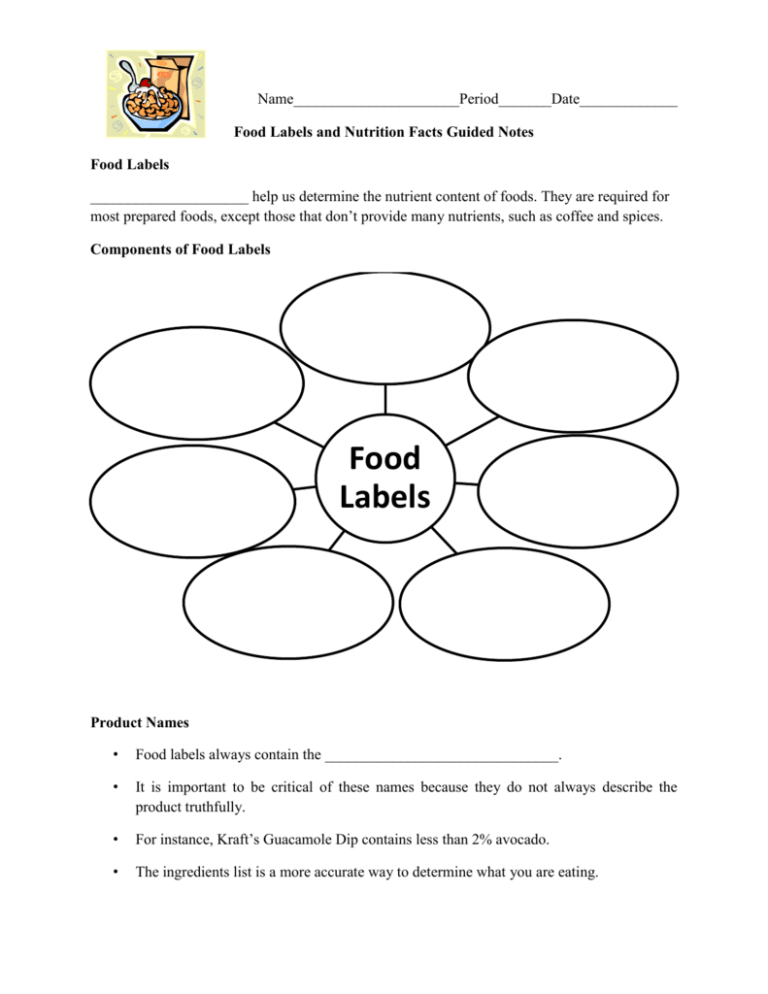
Name______________________Period_______Date_____________ Food Labels and Nutrition Facts Guided Notes Food Labels _____________________ help us determine the nutrient content of foods. They are required for most prepared foods, except those that don’t provide many nutrients, such as coffee and spices. Components of Food Labels Food Labels Product Names • Food labels always contain the _______________________________. • It is important to be critical of these names because they do not always describe the product truthfully. • For instance, Kraft’s Guacamole Dip contains less than 2% avocado. • The ingredients list is a more accurate way to determine what you are eating. Net Contents ____________________ tells you the weight, count, or quantity inside the package. Name and Address of the Manufacturer • The _________________ and ___________________ of the manufacturer is important because it tells you who to contact in the event you have file a complaint about the product. • You can also write to the manufacturer to complement their product- they may send you coupons in return. Ingredients List • For foods with more than one ingredient, the ______________________ are listed underneath the nutrition facts panel. • The ingredients are listed in descending order by __________________, meaning the first ingredient makes up most of the weight of the product, followed by the second ingredient, and so on. • Some ingredients labels list common _________________ found in their processing plants, even if they are not contained in the particular food product. • This is important for those with allergies to remember because it can help control their risk of exposure to things like soy and tree nuts. Nutritional Claims Nutrient Nutritional Claim Content Calorie Free < 5 cals/serving Low Calorie < or = 40 cals/serving Reduced Calorie At least 25% fewer cals/serving than reference food Fat Free < 0.5 g fat/serving Low Fat < or = 3 g fat/serving Reduced Fat < 25% of fat/serving than reference food Sugar Free < 0.5 g sugar/serving Reduced Sugar At least 25% less sugar/serving than reference food High Fiber > or = 5 g fiber/serving Good Source of Fiber 2.5-4.9 g fiber/serving Sell By and Expiration Date • _____________________________ tells you the product should be sold by the store by this date. It can still be consumed for up to a week after this date. • _____________________________ tells you the last day the product should be consumed. • ________________________________ tells you the last date the product is at its freshest. It can still be eaten after this date. Important Vocabulary Word Definition Macronutrients People need to eat these nutrients in large quantities. Micronutrients Examples People need to eat these nutrients in small quantities. Nutrition Facts Panel Number of Servings and Serving Size Macronutrients Percent Daily Value Servings • At the top of the Nutrition Facts panel, you will see the __________________________ and the number of servings in the package. • The rest of the information on the label is based on a ___________________ serving of the product. • If a product contains less than half a gram of a nutrient per serving, it can be rounded down to _________________. Calories • ____________________ on the food label tell you how much energy is in the food product. • Carbohydrates, Proteins, Fats, and Alcohol are the only items that contribute calories. Carbohydrates • ____ calories per gram • Proteins Fats Alcohol • ____ calories per gram • ____ calories per gram • ____ calories per gram Total Fat: 6g • 6g X 9Kcal/g = • Total Carbohydrates: 40g • 40g X 4Kcal/g = • Total Protein: 9g • 9g X 4Kcal/g = Total Calories: Fat + Carbohydrates + Protein = Calories ________ + _________ + _________ = Macronutrients • Fats, carbohydrates, and proteins can be found on nutritional panels. Macronutrients: Fats • Total Fat includes … • _____________________________ • _____________________________ • _____________________________ • _____________________________ • Only saturated and trans fats are required to be listed under total fat. • ____________________ must also be placed on the food label. Macronutrients: Carbohydrates • _______________________ Carbohydrate includes the total amount of sugars, fiber, and starch. • Most of the time, only ____________________ and ________________________ are included in calculating the total calories because fiber does not add calories to the product. • You can find the amount of _____________________ in the product by subtracting the amount of sugar from the total carbohydrates. Macronutrients: Protein • ________________________ can be found towards the bottom of the nutrition panel. • The panel does not always list a recommended amount of protein like it does for the other nutrients because this is based on your body weight. • You need at least _______________ grams of protein per pound. • _________________ X 0.36 = needed protein Micronutrients • The nutrition facts panel must also list the percent daily value of ..... • • • • • • Some products, like Total cereal, list many more vitamins and minerals, but this is not required. • Just because a vitamin or mineral is not listed does not mean it isn’t in the product. Percent Daily Value (DV) • ________________________________________ (%DV) tell you how much of something, whether it’s fat, sugar, or vitamin A, one serving of a product will give you compared to how much the government estimates an adult needs for the entire day. • 5% or less = ______________ source • 10%-19% = ______________ source • 20% and over = ______________ source



